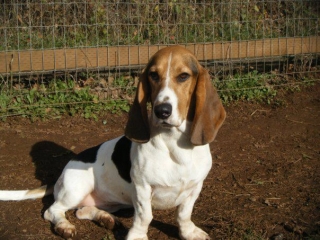Why are You Teaching Your Dog That?

So, there are some words, phrases and cues that I choose not to use with dogs. One of those is, “Look at me.” I don’t say it and I don’t teach it. Of course there’s nothing wrong with it, but I find it redundant and unnecessary in my training, so I don’t use it.
If I want to get someone’s attention, I generally say their name. The expectation is that if I say someone’s name, they will respond by looking at me and at that point I can say whatever it is I need to say. If I say someone’s name and they don’t respond, I can assume they either didn’t hear me or they are ignoring me. No point in saying anything else to them if they can’t hear me or are choosing to ignore me, right?
In the case of dogs, they can almost always hear us. They may be so distracted that it’s hard to respond because some other stimulus has a hold on their attention, but they can hear us. If a dog is choosing to ignore me when I say his name, I must assume that he hasn’t had enough practice responding to his name or that he’s in a situation that is beyond his training skill.
Either way, it’s a training problem and easy to fix. All I have to do is pair the dog’s name with good things. Dog’s name = pepperoni. Dogs’ name = game of tug. Dog’s name = a smile and praise. Reliable rewards and repetition are the keys to success, as they are in all training.
I also have to avoid the mistake of mixing in equations that would cause the dog to ignore me. For instance, Dog’s name = a lecture that he doesn’t understand. Dog’s name = a mean look and being yanked out of the park and into the car. Dog’s name = bath and dog doesn’t like baths. Dog’s name = snatching away a treasure he found and leaving him with nothing to do.
It works the same with people. Just about everyone has a friend who only calls when there is bad news to report or lots of whining to do. While it’s not our name we hear, but their number on our caller ID, we often ignore this friend. There is a history of punishment there that we’d like to avoid. The only thing that gets us to eventually answer is guilt, and dogs don’t have guilt.
If I’ve done my training right and practiced in lots of different places with different distractions, quickly fading the food rewards to life rewards until I have a dog that snaps his head around every time he hears his name, fixing his eyes to mine…why would I have any need to teach a separate cue to ask him to look at me? It’s the purpose of his name, after all.
If this is a dog who gets overly excited about passing dogs, people or bicycles, I would also teach him a sit-stay. If I’m doing the training myself, I probably won’t teach the word stay, though. I will simply teach the dog that sit = put your butt on the ground and remain in that position until I give you further instruction. When a parade of school children goes by, I simply say the dog’s name, he looks at me, I ask him to sit and he remains in a sit until the kids pass. Two words.
I’m certainly not saying that this is right and teaching extra cues is wrong. Not by a long shot. Whatever works for you and the dog you’re training is fine with me. My point is that we often do things just because they are the things that we do. Sometimes we don’t think about what we’re doing and why we’re doing it. Clients will often say, “But, I thought I was supposed to teach him __________.” Well, says who?
What are you teaching? How are you teaching it? Why?




